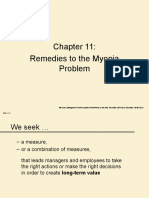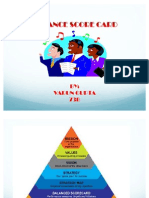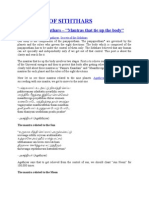Chapter 08
Chapter 08
Uploaded by
Yuxuan SongCopyright:
Available Formats
Chapter 08
Chapter 08
Uploaded by
Yuxuan SongOriginal Description:
Copyright
Available Formats
Share this document
Did you find this document useful?
Is this content inappropriate?
Copyright:
Available Formats
Chapter 08
Chapter 08
Uploaded by
Yuxuan SongCopyright:
Available Formats
Slide 8.
Chapter 8:
Planning and Budgeting
Merchant, Management Control Systems PowerPoints on the Web, 3rd edition, Pearson Education Limited 2012
Slide 8.2
Financial results controls
Three core elements
Financial responsibility centers
The apportioning of accountability for financial results within
the organization
Formal management processes
Planning and budgeting to define performance expectations
and standards for evaluating performance
Motivational contracts
To define the links between results and various organizational
incentives
Merchant, Management Control Systems PowerPoints on the Web, 3rd edition, Pearson Education Limited 2012
Slide 8.3
Planning and budgeting
Produce written plans that specify:
Where the organization wishes to go
How it intends to get there
What results should be expected
Purposes of planning and budgeting processes
To enhance management control
To engage in long(er)-term thinking
To achieve coordination (top-down, bottom-up, sideways)
To establish challenging-but-achievable performance targets
Merchant, Management Control Systems PowerPoints on the Web, 3rd edition, Pearson Education Limited 2012
Slide 8.4
and involving all organizational levels
Incrementally specific, detailed, short-term,
Planning cycle
Strategic
Planning
Programming
Capital
Budgeting
Operational
Budgeting
Relatively broad processes of thinking
about the missions, goals, and strategies
Normally a top-management process
Specification of specific action programs
to be implemented over the next few years
and specification of the resources each
will consume
It involves managers at different levels
(top-down/bottom-up)
Short-term financial planning
Budgets match the organizations
responsibility structure
Emphasis on quantitative data
Merchant, Management Control Systems PowerPoints on the Web, 3rd edition, Pearson Education Limited 2012
Slide 8.5
Characteristics of a budget
It is usually stated in monetary terms
It generally covers a period of one year
It contains an element of management commitment,
that is, the managers agree to accept the responsibility
for attaining the budgeted objectives
The budget is approved by an authority higher than the
budgetee
Once approved, the budget can be changed only under
specified conditions
Periodically, actual financial performance is compared to
budget and variances are analyzed and explained
Merchant, Management Control Systems PowerPoints on the Web, 3rd edition, Pearson Education Limited 2012
Slide 8.6
Budgeting and management control
Budgeting involves setting targets that are
commonly used as standards against which to
evaluate performance results controls
Planning and budgeting processes involve formal
reviews of plans and include the actions that are
felt to be good for the organization to take
action controls
Planning and budgeting processes provide the
needed information for decision making to the
relevant managers personnel controls
Merchant, Management Control Systems PowerPoints on the Web, 3rd edition, Pearson Education Limited 2012
Slide 8.7
The budget preparation process
Budget Committee
ss
e
nc
ua
G
of
os
op
Pr
4. Approval
s
ne
eli
uid
Budget
Department
et
dg
Bu
al
Bottom-Up
I
1.
l
itia
In
2.
3. Negotiation
Top-Down
Business Managers
The budgeting process takes about 4 months in most firms
Merchant, Management Control Systems PowerPoints on the Web, 3rd edition, Pearson Education Limited 2012
Slide 8.8
Types of financial performance targets
Model-based (engineered) / historical / negotiated
Internally / externally-derived
Information asymmetry
Target costing
Benchmarking
Fixed / Flexible
Should managers be held accountable for achieving their
plans regardless of the business conditions they face?
Relative performance targets
Merchant, Management Control Systems PowerPoints on the Web, 3rd edition, Pearson Education Limited 2012
Slide 8.9
Budget participation
Top-down / bottom-up budgeting
The budgetee is both involved and has influence over
setting the budget
Leads to better acceptance of budget targets, and hence,
commitment to achieve them
Is an effective way of information sharing bringing
together corporate priorities and constraints with lowerlevel insights about business potentials and risks
But, potential for slack, bias, conservatism,
Merchant, Management Control Systems PowerPoints on the Web, 3rd edition, Pearson Education Limited 2012
Slide 8.10
Motivation / Performance
Budget target difficulty
Easy
Goal Difficulty
Impossible
Merchant, Management Control Systems PowerPoints on the Web, 3rd edition, Pearson Education Limited 2012
Slide 8.11
Budget target difficulty (continued)
In theory (lab experiments):
Probability
Good targets are about 2540% achievable
Target
Performance
Merchant, Management Control Systems PowerPoints on the Web, 3rd edition, Pearson Education Limited 2012
Slide 8.12
Budget target difficulty (continued)
In practice (field research)
Probability
Targets are about 8090% achievable
Target
Performance
Merchant, Management Control Systems PowerPoints on the Web, 3rd edition, Pearson Education Limited 2012
Slide 8.13
Budget target difficulty (continued)
Probability
Effective vs. ineffective management teams
Target
Performance
Merchant, Management Control Systems PowerPoints on the Web, 3rd edition, Pearson Education Limited 2012
Slide 8.14
Budget target difficulty (continued)
Probability
Low vs. high uncertainty
Target
Performance
Merchant, Management Control Systems PowerPoints on the Web, 3rd edition, Pearson Education Limited 2012
Slide 8.15
Challenging but achievable ...
To minimize dysfunctional management actions
Myopic behavior, data manipulation
To increase managers commitment to budget targets
To reduce the cost of organizational interventions
Management-by-exception
To protect against the cost of optimistic revenue projections
Over-commitment of resources
To create a winning atmosphere and positive attitude
Merchant, Management Control Systems PowerPoints on the Web, 3rd edition, Pearson Education Limited 2012
Slide 8.16
What is a good budget target?
Purpose of Budgeting
Motivation
Planning
Coordination
Cost control
Evaluation
Target Difficulty
Conservative
Best guess
Optimistic
Target should be after-the-fact assessment of what could
have been accomplished, not any of the three choices listed
Merchant, Management Control Systems PowerPoints on the Web, 3rd edition, Pearson Education Limited 2012
Slide 8.17
Beyond Budgeting?
Some principles
Goals
Set relative goals for continuous improvement; not fixed performance contracts
Rewards
Reward success based on relative performance; not on meeting fixed targets
Planning
Make planning a continuous and inclusive process; not a top-down annual event
Coordination
Coordinate interactions dynamically; not through annual planning cycles
Resources
Make resources available as needed; not through annual budget allocations
Controls
Base controls on relative indicators and trends; not on variances against plan
Applicability in practice? Effectiveness? Problems?
Merchant, Management Control Systems PowerPoints on the Web, 3rd edition, Pearson Education Limited 2012
You might also like
- The Ten Authentic Qirā'āt - ( الْقِرَاءَاتُ الْعَشْرُ الْمُتَوَاتِرَةُ بالإنجليزيةDocument331 pagesThe Ten Authentic Qirā'āt - ( الْقِرَاءَاتُ الْعَشْرُ الْمُتَوَاتِرَةُ بالإنجليزيةQuraan Sheikhah100% (5)
- BSC - Chadwick Case StudyDocument7 pagesBSC - Chadwick Case Studyrgaeastindian100% (4)
- 125 Positive Affirmations For KidsDocument2 pages125 Positive Affirmations For KidsFitrah Alami Industri100% (2)
- Balanced Scorecard - OxfordDocument28 pagesBalanced Scorecard - OxfordUmesh Chandra LohaniNo ratings yet
- Tadao Ando PDFDocument27 pagesTadao Ando PDFDiane Frogosa100% (1)
- Strategic Cost Cutting After COVID: How to Improve Profitability in a Post-Pandemic WorldFrom EverandStrategic Cost Cutting After COVID: How to Improve Profitability in a Post-Pandemic WorldNo ratings yet
- Chapter 11Document22 pagesChapter 11Yuxuan SongNo ratings yet
- Chapter 9Document18 pagesChapter 9Ibrahim Genc100% (1)
- F 09420010120134020 PP T 07Document19 pagesF 09420010120134020 PP T 07Stevia TjioeNo ratings yet
- Chapter 10Document19 pagesChapter 10Yuxuan SongNo ratings yet
- Horngren MGMT Ch13Document23 pagesHorngren MGMT Ch13AndyMaviaNo ratings yet
- Test 2Document61 pagesTest 2Tiktak TakNo ratings yet
- Budgeting ConceptsDocument19 pagesBudgeting ConceptsJitendra NagvekarNo ratings yet
- Planning Budgeting and ForecastingDocument16 pagesPlanning Budgeting and ForecastingNicola ButtoloNo ratings yet
- Planning, Budgeting and ForecastingDocument16 pagesPlanning, Budgeting and ForecastingCP Mario Pérez LópezNo ratings yet
- Organizational Analysis and Task AnalysisDocument4 pagesOrganizational Analysis and Task Analysisnisha patelNo ratings yet
- Fiscal PlaningDocument6 pagesFiscal PlaningJason YangaNo ratings yet
- Chapter 14Document19 pagesChapter 14Yuxuan Song100% (1)
- Budgets and Managing MoneyDocument51 pagesBudgets and Managing MoneyIrtiza Shahriar ChowdhuryNo ratings yet
- Chapter 12Document15 pagesChapter 12Yuxuan SongNo ratings yet
- Budget Mid FinalDocument9 pagesBudget Mid Final841388No ratings yet
- Lesson 10 - Financial ManagementDocument8 pagesLesson 10 - Financial ManagementMyline GabinoNo ratings yet
- Budgets and Their Ability To Support Organisational ObjectivesDocument38 pagesBudgets and Their Ability To Support Organisational ObjectivesranjithNo ratings yet
- Balanced Scorecard PresentationDocument25 pagesBalanced Scorecard PresentationSohanul Haque Shanto100% (1)
- Accounting For Managerial Decision (6th Sem Notes)Document36 pagesAccounting For Managerial Decision (6th Sem Notes)Kamal Sachdev67% (3)
- Chapter 1Document3 pagesChapter 1Andrea QuetzalNo ratings yet
- Lesson 10 - Financial ManagementDocument8 pagesLesson 10 - Financial ManagementLand DoranNo ratings yet
- Meiktila University of EconomicsDocument3 pagesMeiktila University of EconomicsKhin Myo MyintNo ratings yet
- Balanced Scorecard (BSC)Document11 pagesBalanced Scorecard (BSC)Sendhil KumarNo ratings yet
- Budgeting and Budgetary ControlDocument31 pagesBudgeting and Budgetary ControlpulsaraminNo ratings yet
- The Balanced ScorecardDocument6 pagesThe Balanced ScorecardAhmad ZydanNo ratings yet
- What Are The Advantages of BudgetingDocument8 pagesWhat Are The Advantages of Budgetingram1312100% (1)
- BUDGETING PresentationDocument6 pagesBUDGETING PresentationJandJ's Art BoxNo ratings yet
- Cma Part 1Document7 pagesCma Part 1anoopmba50% (2)
- Balanced ScorecardDocument32 pagesBalanced ScorecardKapil Dhanania100% (1)
- Best Practices For Planning and BudgetingDocument20 pagesBest Practices For Planning and BudgetingSilky SmoothNo ratings yet
- Lans AND Lanning EchniqueDocument47 pagesLans AND Lanning EchniqueVan FabelaNo ratings yet
- AC 312 Management Accounting I - Budgeting and Planning - Margaret Aeka ID 2270Document10 pagesAC 312 Management Accounting I - Budgeting and Planning - Margaret Aeka ID 227022700021maaeNo ratings yet
- The-Balanced-Scorecard-Unit 3 PDFDocument6 pagesThe-Balanced-Scorecard-Unit 3 PDFmadhumithaNo ratings yet
- F2 Notes LatestDocument267 pagesF2 Notes LatestWaseem Ahmad50% (2)
- Balanced ScorecardDocument22 pagesBalanced Scorecardshreyas_1392100% (1)
- Cost II Chapter ThreeDocument106 pagesCost II Chapter Threefekadegebretsadik478729No ratings yet
- Module Study Pack (Stretigic Management Accounting)Document328 pagesModule Study Pack (Stretigic Management Accounting)Rimon BD100% (3)
- 09 - Budget PreparationDocument17 pages09 - Budget PreparationJason Kurniawan50% (4)
- Balanced ScorecardDocument36 pagesBalanced Scorecardwessam777No ratings yet
- Study Guide Week5Document3 pagesStudy Guide Week5John AltmanNo ratings yet
- Top Down and Bottoms Up Approach in BudgetingDocument7 pagesTop Down and Bottoms Up Approach in BudgetingChetan SaxenaNo ratings yet
- Chapter - 20: Effective ControlDocument32 pagesChapter - 20: Effective Controlcooldude690No ratings yet
- Balance Scorecard PPT - Varun73B OSDocument47 pagesBalance Scorecard PPT - Varun73B OSVarun Gupta100% (1)
- pp09Document51 pagespp09Laa SihameNo ratings yet
- Balanced ScorecardDocument23 pagesBalanced ScorecardMalvika Pattnaik100% (1)
- Balanced ScorecardDocument13 pagesBalanced Scorecardhitchhiker25100% (1)
- P5 Apc NOTEDocument248 pagesP5 Apc NOTEprerana pawarNo ratings yet
- Bus-Dmy Summary For Budget and Financial ManagementDocument5 pagesBus-Dmy Summary For Budget and Financial ManagementkoolsurdieNo ratings yet
- Project Management: A Managerial Approach 4/e: by Jack R. Meredith and Samuel J. Mantel, JRDocument30 pagesProject Management: A Managerial Approach 4/e: by Jack R. Meredith and Samuel J. Mantel, JRHina AyubNo ratings yet
- Financial AspectDocument53 pagesFinancial AspectNeha Sable Deshmukh100% (1)
- Balanced Scorecard Implementation in Smes: From Theory To PracticeDocument33 pagesBalanced Scorecard Implementation in Smes: From Theory To PracticeLumi LuminitaNo ratings yet
- Bes'S Institute of Management Studies & Research: Report On Advanced Financial ManagementDocument34 pagesBes'S Institute of Management Studies & Research: Report On Advanced Financial Managementcapricorn_niksNo ratings yet
- Balance ScoreboardDocument8 pagesBalance ScoreboardRj Fashionhouse100% (1)
- Managerial Accounting EssayDocument8 pagesManagerial Accounting EssayPatrick PetitNo ratings yet
- How To Initiate A Performance Framework in BudgetingDocument24 pagesHow To Initiate A Performance Framework in BudgetingInternational Consortium on Governmental Financial ManagementNo ratings yet
- The Balanced Scorecard: Turn your data into a roadmap to successFrom EverandThe Balanced Scorecard: Turn your data into a roadmap to successRating: 3.5 out of 5 stars3.5/5 (4)
- Cost Reduction Strategies for the Manufacturing Sector With Application of Microsoft ExcelFrom EverandCost Reduction Strategies for the Manufacturing Sector With Application of Microsoft ExcelNo ratings yet
- Chapter 17Document9 pagesChapter 17Yuxuan Song100% (1)
- Chapter 12Document15 pagesChapter 12Yuxuan SongNo ratings yet
- Chapter 14Document19 pagesChapter 14Yuxuan Song100% (1)
- Chapter 13Document16 pagesChapter 13Yuxuan SongNo ratings yet
- Chapter 1Document9 pagesChapter 1Anonymous lp6TeWExPeNo ratings yet
- Action, Personnel, and Cultural ControlsDocument15 pagesAction, Personnel, and Cultural Controlsevaluv100% (1)
- Yaneva FiveWays ProofsDocument197 pagesYaneva FiveWays ProofsJose LlanoNo ratings yet
- Facts About The Income TaxDocument11 pagesFacts About The Income TaxAnonymous nYwWYS3ntV100% (1)
- Koyre, A. - The Political Function of The Modern LieDocument36 pagesKoyre, A. - The Political Function of The Modern LieErickson SantosNo ratings yet
- Teaching Guide in Understanding Culture, Society and Politics ContentDocument3 pagesTeaching Guide in Understanding Culture, Society and Politics ContentCristy GallardoNo ratings yet
- Operational Art PrimerDocument7 pagesOperational Art PrimerЉупчо Велков100% (2)
- Kingdom of SiththarsDocument7 pagesKingdom of Siththarsutcm77No ratings yet
- Geoup 6 Compiled ReportsDocument8 pagesGeoup 6 Compiled ReportsSierra Felecia RiegoNo ratings yet
- Evidence OutlineDocument38 pagesEvidence Outlinengs12No ratings yet
- Robert ResumeDocument4 pagesRobert ResumeRobert DuPreeNo ratings yet
- Karma YogaDocument17 pagesKarma YogamahamayaNo ratings yet
- Text Types - DescriptiveDocument10 pagesText Types - DescriptiveRobin GunawanNo ratings yet
- Decentralization, Corruption & Social Capital - Sten Widmalm - 2007 PDFDocument232 pagesDecentralization, Corruption & Social Capital - Sten Widmalm - 2007 PDFAji DeniNo ratings yet
- Assignment in UNDS111 (Concept Check)Document5 pagesAssignment in UNDS111 (Concept Check)Feizhen MaeNo ratings yet
- Conversation SkillsDocument33 pagesConversation SkillsWenny SiraitNo ratings yet
- Eugene Garver: The Uses and Abuses of Philosophy: Aristotle'S Politics V As An ExampleDocument20 pagesEugene Garver: The Uses and Abuses of Philosophy: Aristotle'S Politics V As An ExampleFranditya UtomoNo ratings yet
- VygotskyDocument11 pagesVygotskyGenie Soriano100% (2)
- Balut Elementary School: Jhayred D. AlmazarDocument14 pagesBalut Elementary School: Jhayred D. Almazarritz manzanoNo ratings yet
- Chapter 4 - Dynamic AnalysisDocument16 pagesChapter 4 - Dynamic AnalysisAquinoAquinoNo ratings yet
- Dover BeachDocument4 pagesDover BeachEvangelos TzNo ratings yet
- New Ideas in Recognition of Cancer and Neutrosophic SuperHyperGraph With Multipartite and Cycle by Perfect DominationDocument85 pagesNew Ideas in Recognition of Cancer and Neutrosophic SuperHyperGraph With Multipartite and Cycle by Perfect DominationHenry GarrettNo ratings yet
- Qasida For Sayyida ZaynabDocument8 pagesQasida For Sayyida ZaynabGhettoSufiNo ratings yet
- Eapp 4TH Quarter Exam ReviewerDocument8 pagesEapp 4TH Quarter Exam ReviewerNicole CardenasNo ratings yet
- Behaviorist PerspectiveDocument32 pagesBehaviorist Perspectivecarl dianneNo ratings yet
- Apc Problem Set PDFDocument3 pagesApc Problem Set PDFEarvin Jay GatanNo ratings yet
- Multiple RegressionDocument17 pagesMultiple RegressionHazilah Mohd Amin100% (1)
- The Night Is A Jungle, by Sant Kirpal SinghDocument420 pagesThe Night Is A Jungle, by Sant Kirpal SinghSant Mat100% (3)
- 2002 AP® ENGLISH LANGUAGE AND COMPOSITION FREE-RESPONSE QUESTIONS Question 2Document3 pages2002 AP® ENGLISH LANGUAGE AND COMPOSITION FREE-RESPONSE QUESTIONS Question 2Valentin ShatilenkoNo ratings yet





























































































